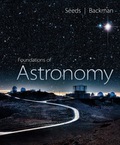
Concept explainers
The evidence that suggests human observed astronomical phenomena.
Answer to Problem 1RQ
The alignment of buildings, festivals based on season, worship solar and lunar deity and the Mayan manuscripts are some of the evidences that suggest human observed astronomical phenomena.
Explanation of Solution
There are several evidences exists which support observation of astronomical phenomena by early people. The alignment of buildings at that time was based on observable celestial phenomenon. Most of the tombs are oriented towards the rising sun. Some of the alignments are severed the purpose of an annual calendar.
Celestial bodies are observed by early people for ceremonial purposes, for celebrating religious festivals. Evidences are also obtained from art works such as petroglyphs, and pictographs depicting astronomical events and object.
Mayan manuscripts are another important evidence and most helpful astronomical reference. Even though most of the books are being burned by Spanish missionaries, the survived four books contain information about motion of Venus, and eclipses of Moon.
Conclusion:
Therefore, the alignment of buildings, festivals based on season, worship solar and lunar deity and the Mayan manuscripts are some of the evidences that suggest human observed astronomical phenomena.
Want to see more full solutions like this?
Chapter 4 Solutions
EBK FOUNDATIONS OF ASTRONOMY
- Hi! I need help with these calculations for part i and part k for a physics Diffraction Lab. We used a slit width 0.4 mm to measure our pattern.arrow_forwardExamine the data and % error values in Data Table 3 where the angular displacement of the simple pendulum decreased but the mass of the pendulum bob and the length of the pendulum remained constant. Describe whether or not your data shows that the period of the pendulum depends on the angular displacement of the pendulum bob, to within a reasonable percent error.arrow_forwardIn addition to the anyalysis of the graph, show mathematically that the slope of that line is 2π/√g . Using the slope of your line calculate the value of g and compare it to 9.8.arrow_forward
- An object is placed 24.1 cm to the left of a diverging lens (f = -6.51 cm). A concave mirror (f= 14.8 cm) is placed 30.2 cm to the right of the lens to form an image of the first image formed by the lens. Find the final image distance, measured relative to the mirror. (b) Is the final image real or virtual? (c) Is the final image upright or inverted with respect to the original object?arrow_forwardConcept Simulation 26.4 provides the option of exploring the ray diagram that applies to this problem. The distance between an object and its image formed by a diverging lens is 5.90 cm. The focal length of the lens is -2.60 cm. Find (a) the image distance and (b) the object distance.arrow_forwardPls help ASAParrow_forward
 Foundations of Astronomy (MindTap Course List)PhysicsISBN:9781337399920Author:Michael A. Seeds, Dana BackmanPublisher:Cengage Learning
Foundations of Astronomy (MindTap Course List)PhysicsISBN:9781337399920Author:Michael A. Seeds, Dana BackmanPublisher:Cengage Learning Stars and Galaxies (MindTap Course List)PhysicsISBN:9781337399944Author:Michael A. SeedsPublisher:Cengage Learning
Stars and Galaxies (MindTap Course List)PhysicsISBN:9781337399944Author:Michael A. SeedsPublisher:Cengage Learning

 Stars and GalaxiesPhysicsISBN:9781305120785Author:Michael A. Seeds, Dana BackmanPublisher:Cengage Learning
Stars and GalaxiesPhysicsISBN:9781305120785Author:Michael A. Seeds, Dana BackmanPublisher:Cengage Learning AstronomyPhysicsISBN:9781938168284Author:Andrew Fraknoi; David Morrison; Sidney C. WolffPublisher:OpenStax
AstronomyPhysicsISBN:9781938168284Author:Andrew Fraknoi; David Morrison; Sidney C. WolffPublisher:OpenStax





